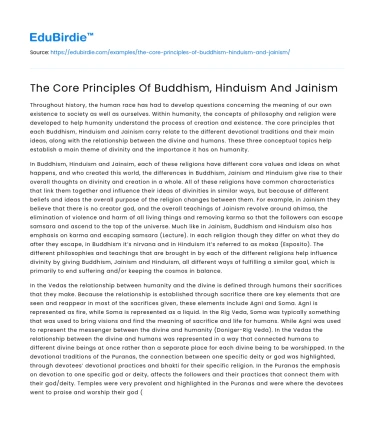Throughout history, the human race has had to develop questions concerning the meaning of our own existence to society as well as ourselves. Within humanity, the concepts of philosophy and religion were developed to help humanity understand the process of creation and existence. The core principles that each Buddhism, Hinduism and Jainism carry relate to the different devotional traditions and their main ideas, along with the relationship between the divine and humans. These three conceptual topics help establish a main theme of divinity and the importance it has on humanity.
In Buddhism, Hinduism and Jainsim, each of these religions have different core values and ideas on what happens, and who created this world, the differences in Buddhism, Jainism and Hinduism give rise to their overall thoughts on divinity and creation in a whole. All of these religions have common characteristics that link them together and influence their ideas of divinities in similar ways, but because of different beliefs and ideas the overall purpose of the religion changes between them. For example, in Jainism they believe that there is no creator god, and the overall teachings of Jainism revolve around ahimsa, the elimination of violence and harm of all living things and removing karma so that the followers can escape samsara and ascend to the top of the universe. Much like in Jainism, Buddhism and Hinduism also has emphasis on karma and escaping samsara (Lecture). In each religion though they differ on what they do after they escape, in Buddhism it’s nirvana and in Hinduism it’s referred to as moksa (Esposito). The different philosophies and teachings that are brought in by each of the different religions help influence divinity by giving Buddhism, Jainism and Hinduism, all different ways of fulfilling a similar goal, which is primarily to end suffering and/or keeping the cosmos in balance.
Save your time!
We can take care of your essay
- Proper editing and formatting
- Free revision, title page, and bibliography
- Flexible prices and money-back guarantee
In the Vedas the relationship between humanity and the divine is defined through humans their sacrifices that they make. Because the relationship is established through sacrifice there are key elements that are seen and reappear in most of the sacrifices given, these elements include Agni and Soma. Agni is represented as fire, while Soma is represented as a liquid. In the Rig Veda, Soma was typically something that was used to bring visions and find the meaning of sacrifice and life for humans. While Agni was used to represent the messenger between the divine and humanity (Doniger-Rig Veda). In the Vedas the relationship between the divine and humans was represented in a way that connected humans to different divine beings at once rather than a separate place for each divine being to be worshipped. In the devotional traditions of the Puranas, the connection between one specific deity or god was highlighted, through devotees’ devotional practices and bhakti for their specific religion. In the Puranas the emphasis on devotion to one specific god or deity, affects the followers and their practices that connect them with their god/deity. Temples were very prevalent and highlighted in the Puranas and were where the devotees went to praise and worship their god (Lecture). This is one of the big differences between the connection between the divine and humanity, when it comes to the Puranas and the Vedas.
Divinity is shaped differently in the Puranas, through the three main devotional traditions that are seen. In each of the three different traditions the emphasis on monotheism and one particular god/deity being greater than the rest helps shape that particular religion and devotional tradition. The Puranas change the idea of divinity and shift it to one that follows the one god/deity that is seen as more powerful, whether that be Shiva, Devi, or Vishnu. Each specific devotional tradition shifts to follow that specific god/deity that is seen as the most powerful. In the different traditions, the creations stories and the other stories told are used to reestablish one particular god as the most powerful deity or divine being.
Divinity gives people reasons to do things and live their everyday life. Divinity in a whole gives life meaning and purpose. It helps us to define ourselves and label humanity as an important element in this world. This can be seen through the way that the relationship between god and humanity is defined, and so many other elements of the different religions/devotional traditions. for It can also be seen through the the many different religions and devotional traditions that divinity establishes something as higher and more significant than humanity itself and allows humans to put their energy into something that is bigger than themselves. The way that divinity helps humans establish a balance in the world can be seen through.






 Stuck on your essay?
Stuck on your essay?

